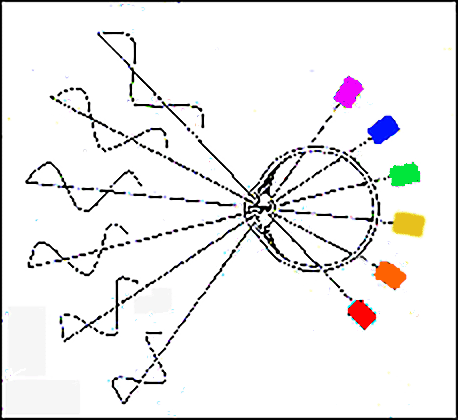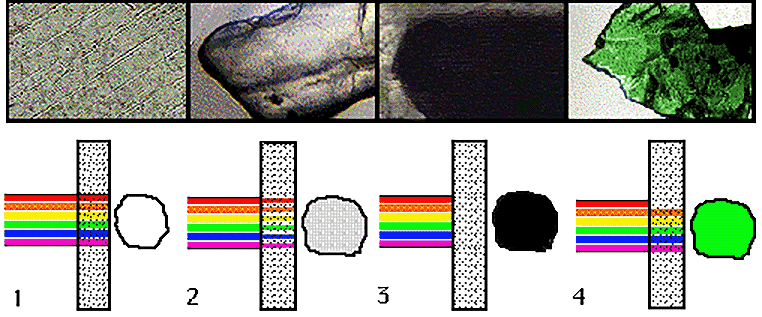
Opaque and transparent crystals
Colour of transparent crystals
Color as a diagnostic character
Some electromagnetic radiations produce certain sensations in the human organism which are perceived by the external sensors which we call senses, such as sound, heat or in this case, light, which we perceive with the eye. But only a short interval of frequencies causes this sensation.
Moreover, each frequency manifests itself in a different way, corresponding to the sensation that we know as colour.

When different radiations, capable of activating the eye sensors, come together in the same beam, the result is a sensation which we know as white light or white colour.
Thus the perception of "white" is provoked by the simultaneous presence of all the "colours".
When a beam of white light crosses a prism, the radiations present, which have different frequencies, wave lengths and velocities, make the crystal show different refraction indices for each one of the components, meaning that their paths diverge unequally and thus the different colours are separated. A primitive beam can be reconstructed by interposing a lens.
Not only can white light be constructed with the sum of all the visible radiations but also with some pairs of "colours". These colours, which together give white light, are known as complementary colours.
Green and red are complementary, and when superimposed, they generate the colour white. By interposing an object which prevents one of these radiations from passing through it, there is no sum and the colour which has been able to pass through appears.
Blue and orange are another pair and the third pair is made up of yellow and violet.
In the following video, white light is produced from the complementary colors blue and orange.
Opaque and transparent crystals
As crystals refract light, they absorb part of the incident radiations. The absorption is always proportional to the thickness of the crystal.
When absorption is total, no light can pass through and the crystal is opaque (1), whereas if part of the light can pass through, the crystal is known as transparent (2).

Given the thinness of the preparations, most crystals are transparent, although they may seem opaque when we observe them macroscopically.
Colour of transparent crystals
When the absorption of light is homogenous in all the wave lengths and with a very low value, the crystal appears to be white (1). As the absorption increases, the crystal gradually appears to be greyish (2). When the absorption is total for a certain wave length, the crystal appears to be the colour of the complementary colour (3).
Remember that when we see a mineral with a certain colour, it is because the radiations corresponding to its complementary colour have been absorbed.

In part 4 of the figure, the mineral absorbs the radiations corresponding to red and allows those corresponding to the other five basic colours to pass through it.
Orange mixes with its complementary colour blue to give white light. Yellow together with violet also give white light. The only colour which is not nullified by its complementary colour, as this has been absorbed by the crystal, is green. Consequently, the light that comes out of the crystal is green.
The following video shows how when inserting a yellow-orange filter into a beam of white light (as if it were a yellow-orange mineral) in the spectrum resulting from the dispersion of light by a prism, the colors violet and blue are missing (they are have absorbed the radiation corresponding to their complementary colors, violet-orange).
Color as a diagnostic character
Natural color is the first observation a mineralogist relies on for mineral identification. It is a property of high diagnostic power and very easy to assess. There are crystals that always appear colorless in all sections* (quartz, feldspars, muscovite, kyanite = dysthene, sillimanite, olivine, garnet, calcite, aragonite, gypsum...), other colorless or colored depending on the size of the grains (tourmaline, chlorite, andalusite, epidote, chloritoid, glaucophane ...) and others are always (or almost always)colored (biotite, hornblende, augite, staurolite, piedmontite, rutile...)
*That is, all the possible sections in which the mineral could have fallen in the thin section.
Some examples of the color of minerals in thin section.
| Colorless (white, gray) | |||||
| Yellow | |||||
| Brown | |||||
| Green | |||||
| Blue | |||||
| Red | |||||
| Black (opaque) |